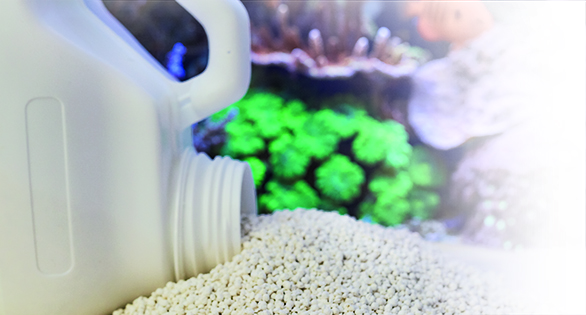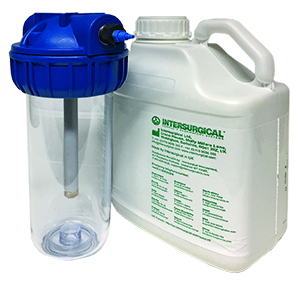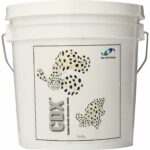
Medical-grade soda lime can offer constant pH control by absorbing CO2 from air entering the aquarium skimmer.
Using a simple new method, the pH of many marine aquariums can be stabilized without directly treating the water
article & images by Steffen Klos
Excerpt from CORAL, June/July 2017, Volume 14, Number 4
pH is an important water chemistry parameter in a seawater aquarium. Mineral deficiencies (carbonate hardness) or strong organic acid production (excessive bioload) destabilize the pH. Usually, a pH value between 7.8 and 8.4 is ideal for a marine aquarium. But numerous reef tanks have notoriously low pH values, even when the carbonate hardness is normal, and often the cause is not known.

Soda lime beads, which turn from white to violet as they absorb CO2 from air.
If you have a pH problem in your aquarium, you must isolate the cause. First, make sure that you measure correctly, and always do it at the same time of day—what time you choose is unimportant. Algae absorb CO2 from the water during the lighting phase, which raises the pH during the day. It is highest at the end of the illumination phase in the evening. During the night, no photosynthesis takes place and CO2 is released by all the organisms, so the pH drops.
If the pH is too low (7.8 or lower during the day or in the evening) and you have ruled out measurement error, the problem could be a surplus of CO2 from the room air. Some calcium reactors release excess CO2 into the water or the air; such a problem can be solved technically, but if the CO2 emanates from the room air, for example from the breathing of humans and animals, then you have to take other steps.
Conventional pH stabilization
A popular way to stabilize the pH during the day is to operate an algae refugium in the filter sump. The refugium is illuminated when the aquarium is dark, so photosynthesis by the algae largely prevents the pH drop. There are also many products in the specialist trade that can be used to stabilize the pH, either directly, on the basis of sodium hydroxide, or indirectly, via the carbonate hardness—for example, with sodium hydrogen carbonate. However, using these methods is risky and affects the water chemistry.
In many cases, the problem can be solved, or at least mitigated, in a very simple way. This new method is still largely unknown in the marine hobby, and I am happy to introduce it here. It is cost-effective in any aquarium that operates with a skimmer, and it is completely safe for the aquarium and its animals because nothing is actively dosed into the tank—you cannot accidentally overdose and change any parameters other than the pH value.
A skimmer not only removes proteins from the water, but also carries out a gas exchange with atmospheric air. This means that CO2-rich air inevitably increases the CO2 in the aquarium, so if there are many people and/or animals in the room, the CO2 is higher and the pH value is reduced. The easiest way to keep the CO2 concentration low in the room air is, of course, regular ventilation. But this is not always possible to the extent required, depending on the outside temperature or season. Thus, the problem cannot be solved in every room, even if you have large indoor plants that absorb CO2.

Medical-grade soda lime is readily available and can be used in an aquarium system in a canister filter through which air is drawn into a protein skimmer.
Elevating the pH with soda lime
Soda lime, the key to this new method, is well known to experienced divers and intensive care nurses, because it is used for rebreather diving and anesthesia equipment. Soda lime is a combination of calcium hydroxide and sodium hydroxide on a special carrier material. These two substances bind CO2 from the air. The procedure is not new, but in the past the substances used were potassium hydroxide and barium hydroxide. Respiratory lime is characterized by the fact that it binds CO2 from the air when it is in direct contact. Three and a half ounces (100 g) of sodium hydroxide can bind 23 liters of CO2. The most effective granule size is 2.5 mm.
The procedure is simple: the soda lime is put into a filter cartridge upstream of the skimmer’s air intake. All the air entering the skimmer must pass through the lime, which scrubs the CO2. When the lime is saturated with CO2 from the air, it becomes acidic and the color indicator in it turns blue.
In my 152-gallon (576-L) reef tank the pH usually fluctuates between 7.8 and 8.0 during the day. To stabilize it above 8.0, I put 0.52 quart (0.5 L) of the fine granules into a filter cartridge and installed it in the manner described above. By the following day I measured no values below 8.1. The amount of fluctuation in the pH value also decreased—in the morning it was 8.1, in the evening 8.2. After a short time I noticed that the consumption of calcium and carbonates in the aquarium greatly increased; I attribute this to increased coral growth due to the higher pH. Some of my friends have had exactly the same experiences, and none of us have seen any negative effects.
Medical grade soda lime or respiratory lime can be easily found online, and filter cartridges can be obtained from aquarium supply companies. I would be delighted if CORAL readers who have experience with this method posted their results here as Comments. We will publish a follow up in a future issue of the magazine.
SOURCES






I’ve been using soda lime for more than a year now and it really helps. My aquarium is in a place where it’s not practical to keep proper ventilation and pH levels use to suffer as a consequence.
With soda lime in a filter connected to the skimmer air intake I can achieve a similar increase in the lower pH level as yours.
The downside, a 0,5 litro load lasts less than a month. I need to check with the local suppliers of medial stuff such as Drager but I guess they will be reluctant to sell it for non porfessional use. So far I’m using the TLF product which is not available in Spain.
Sorry about the horrible typos. It was (mis)typed on an iPad 🙂
One issue that should be mentioned is that traditional soda lime will change back from violet to light yellow over time if not exposed to CO2. This color change back does not mean they will continue to to absorb CO2 and in the medical field the beads are changed out on regular intervals. In the veterinary world soda lime in changed out after 12 -14 hrs of use. There is a newer version that will not change back and can be a reliable indicator on when they need to be changed.
I have been using this method very successfully. The soda lime will last much longer if the air has at least some humidity it. I live in Denver, Colorado where the air is very dry, and was using up media very quickly. The solution was to put another plastic jar, kept partially full of water, in front of the container of soda lime. Air enters the top of the jar through a short length of tubing that stops just above the water level (you can extend the tubing down into the water, but then it makes bubbling noises). Humidified air leaves the jar through a second piece of tubing that begins just above water level and goes into the input of the container of soda lime (do not extend that outgoing piece of tubing into the water, or you might suck water into the soda lime).
Genius. I have a dual canister system for GFO/carbon not in use. I can simply stick some water in canister 1 to keep the humidity going.
This method works extremely well. My ph was constantly under 8.0 dipping under 7.7 at night even though I was/ am using kalkwasser. As per an article I had read, I tested my water by removing some from the tank, inserting my ph probe and agitating the water. Viola’, my ph went up significantly, indicating that I had excess Co2 in my water. Increased agitation/ circulation helped, but not enough. I went so far as to run tubing to the outside of the house to draw fresh air in, connected to the air intake of the skimmer. After some research I found out about soda lime and ordered some online. I placed some into a small reactor canister connected to the air intake of the skimmer. It worked so well that I was now worried that my ph would rise too high (it did not). As one of the previous commenters correctly mentioned, the soda lime is more efficient when there is some moisture in the air. I solved this by placing a small spacer in the bottom of the canister and adding a small amount of water to that space. Enough so that it did not touch the soda lime. The only downside is that, in a 125 gal tank, It used up a gallon of soda lime per month. So cost can be an issue.
I have been using this method for about 4 years now and have only had good results. I use a generic ‘dive (rebreather) lime’ which I can easily source in 25 liter drums, here in the UK (damp/high humidity here too!). I haven’t used a standard filter before as I wanted a cheap solution so use a 1.5 liter fizzy drink bottle with a filter sponge circle top and bottom to stop the media spilling out. The bottle lid has a hole in it to allow a 1/4 tube in to draw air through the media; at the base i have drilled multiple small holes below the top of the filter sponge. Simple and cheap! Soda Lime a little more expensive tho’.
In honesty, I really didn’t think it would work but the pH starting dipping below 7.5 in my 400 gallon tank after it was set up for 18 months so started to use this process to good effect – over two days the pH moved up to 7.9 and then a week later it peaked/stabilized at 8.1 in the day and 7.9 at night.
I replace the media after approx. 2 months but monitor the pH through my calc reactor daily. I stopped using the lime with the color indicator after about a year as it was much more expensive. Hope the article and comments give people confidence to try this non-invasive process.
I don’t use the soda lime but I did set up an air pump that draws air from outside and bubbles it into my sump. I’ve found it really helps the ph during very hot/very cold weather when the house is closed up tight. I can even notice the ph is better when there are fewer people in the house. The ph never drops below 8 since I added the exterior air source.